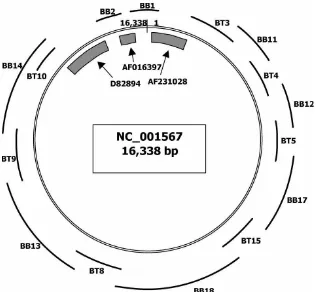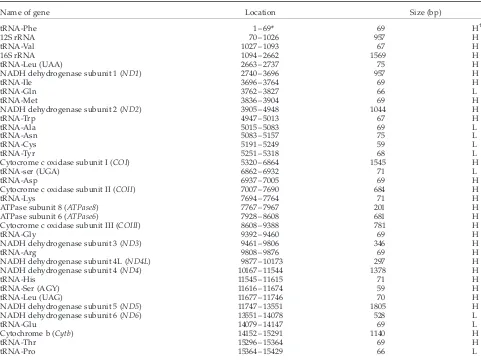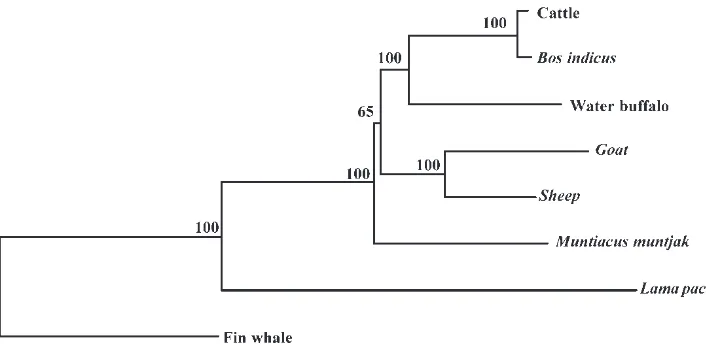See discussions, stats, and author profiles for this publication at: https://www.researchgate.net/publication/8108583
Water Buffalo ( Bubalus bubalis ): Complete
Nucleotide Mitochondrial Genome Sequence
Article in DNA Sequence · October 2004
Impact Factor: 0.41 · DOI: 10.1080/10425170400019318 · Source: PubMed
CITATIONS
19
READS
190
5 authors, including:
Pietro Parma
University of Milan
88PUBLICATIONS 974CITATIONS
SEE PROFILE
gian franco Greppi
Università degli Studi di Sassari
67PUBLICATIONS 535CITATIONS
SEE PROFILE
Short Communication
Water Buffalo (
Bubalus bubalis
): Complete Nucleotide
Mitochondrial Genome Sequence
PIETRO PARMAa,*, MARTA ERRA-PUJADAb, MARIA FELIGINIc, GIANFRANCO GREPPIdand GIUSEPPE ENNEe
aIstituto Sperimentale Italiano “Lazzaro Spallanzani”, Laboratorio di Epigenomica Applicata (LEA), Fondazione Parco tecnologico Padano, Lodi, Italia; b
Dipartimento di Microbiologia e Genetica, Universita` degli Studi, Pavia, Italia;cIstituto Sperimentale Italiano “Lazzaro Spallanzani”, Laboratorio di Epigenomica Applicata (LEA), Fondazione Parco tecnologico Padano, Lodi, Italia;dDipartimento di Clinica Medica Veterinaria, Universita` degli Studi, Milano, Italia and Istituto Sperimentale Italiano “Lazzaro Spallanzani”, Laboratorio di Epigenomica Applicata (LEA), Fondazione Parco tecnologico Padano, Lodi, Italia;eDipartimento di Scienze Zootecniche, Universita` degli Studi, Sassari, Italia
(Received 30 June 2004)
In this work, we report the whole sequence of the water buffalo (Bubalus bubalis) mitochondrial genome. The water buffalo mt molecule is 16.355 base pair length and shows a genome organization similar to those reported for other mitochondrial genome. These new data provide an useful tool for many research area, i.e. evolutionary study and identification of food origin.
Keywords: Water buffalo; Mitochondrial genome; Evolution
Database Accession No: AF231028; D82894; AF016397
MAIN TEXT
Availability of mitochondrial genome sequences represents a very important tool for many research area. Mitochondrial DNA or derived amminocidic sequences have been used for studying the phylo-genetic correlations between different species or breeds from the same species. These kind of studies have been both reported for water buffalo (Bubalus bubalis) using only a small, but significative, part of the mitochondrial genome (Tanakaet al., 1996; Kiersteinet al., 2004).
Eucaryotic cells contains only two copies of nuclear genome, in contrast to the mitochondrial genome that are present in many copies in a single cell. This abundance of genetic material represents a very important advantage in studies targeted to the identification of the origin of alimentary product
in which the DNA present is often degraded and consequently not suitable for molecular biology analysis. Concerning the water buffalo species, the small part of the mitochondrial genome available as today has been used to design a specific PCR test in order to determine the origin of the mozzarella cheese (Botteroet al., 2002).
Finally mutation in mitochondrial genome sequences have been identified as responsible for genetic defects. In humans, Leigh syndrome has been explained with mutations in the ND5 mito-chondrial gene (Sudoet al., 2004).
During the last years there has been a considerable progress in the sequencing of complete mtDNA genomes. Regarding the most important livestock species the complete mitochondrial genome has been published for cattle (Anderson et al., 1982), pig (Linet al., 1999), sheep (Hiendlederet al., 1998), horse (Xu and Arnason, 1994) and goat (Parmaet al., 2003). For those concerning water buffalo (Bubalus bubalis) only a very small part of the mitochondrial genome is available. These concerns a partial sequence of t-RNA Phe and 12S ribosomal gene (GenBank AF231028), the cytochrome b gene (D82894) and the D-loop region (AF016397). The number of water buffalo mitochondrial genome base pair available before this report is 2,262.
In this work, we report the first complete nucleotide sequence of water buffalo mtDNA mole-cule and compare it with those of others species.
ISSN 1042-5179 print/ISSN 1029-2365 onlineq2004 Taylor & Francis Ltd DOI: 10.1080/10425170400019318
Briefly, the available water buffalo sequences (GenBank Accession No: AF231028, D82894 and AF016397), were first aligned with the cattle mtDNA (NC_001567) as shown in Fig. 1; the first base of this genome was placed at the start of t-RNA Phe sequence. The gaps within these three sequences were amplified by PCR using water buffalo specific primers (BB1 and BB2). In order to complete the full sequence between AF231028 and D82894, two set of PCR were designed: the first one was on cattle sequence (BT3, BT4, BT5, BT15, BT8, BT9, BT10). The second one was on water
buffalo specific sequence (BB11, BB12, BB17, BB18, BB13, BB14). The sequences of these primers and the amplification conditions are reported in Table I. Genomic DNA was extracted from peripheral blood of one male water buffalo by using standard commercial kit (Quiagen blood kit). PCR amplifica-tions, performed in a Biometra Trio-Thermobloch, were conducted in a 30 ul volume containing 1.5 mM MgCl2, 200mM of each dNTP, 1mM of each primer and 2 units of AmpliTaq Gold Polymerase (Applied Biosystems). Characteristics of the PCR cycles are
FIGURE 1 Strategy applied for completing the water buffalo mtDNA nucleotide sequence. Legend Available sequences are from:NC_01567 (Andersonet al., 1982); AF231028 (Kuznetsovet al., 2001); D82894 (Tanakaet al., 1996); AF016397 (Lauet al., 1997).
TABLE I Primers and PCR conditions for gaps amplifications
PCRs Forward primer 50
!30 Reverse primer 50!30 Amplification profile (35 cycles)
BB1 gatcacgagcttgatcacca atgcccgctcctcttagttt 968C 10
–558C 10
–728C 10
BB2 tcacatggattggaggacag atccttgcctgaagggttg 968C 10
–558C 10
–728C 10
BT3 ccgtcaccctcctcaagtaa ggtatccgtttctaaaaggctg 968C 10
–558C 10
–728C 10
BT4 cgcacgagggttttactgtc aaggagaggatttgaatctctg 968C 10–558C 10–728C 10
BT5 agtctcgggcttcaacgtag gggatgccctgtgttacttc 968C 10
–558C 10
–728C 10
BT15 gaactctgctcggagacgac gagttggtaagacaattcca 968C 10–558C 10–728C 10
BT8 atcggaggagctacacttgc aatgcgatgatgacgagta 968C 10
–558C 10
–728C 10
BT9 tttacacgggaaaatgcact ggattttccggttgcagcta 968C 10–558C 10–728C 10
BT10 tcactcgcccaaataaaagc agcagggaggtcaatgaatg 968C 10
–558C 10
–728C 10
BB11 gctggttgtccagaaaatgaa cgggaaggtcaatttcactg 968C 10–55
8C 10–72
8C 10
BB12 aaggttcgtttgttcaacgatt tatgggttgtgggatgttcc 968C 10
–558C 10
–728C 10
BB17 ggccaatggaccgtaataaa aatcagttatcaaacacctcca 968C 10–558C 10–728C 10
BB18 gccctaggcttcattttcct ggcttggattatagccactgc 968C 10
–558C 10
–728C 20
BB13 gctgcctgatattgacactttg gggcttctattgttagattcac 968C 10–558C 10–728C 10
BB14 caaacacagcagccctacaa agcagggaggtcaatgaatg 968C 10
–558C 10
–728C 20
P. PARMAet al.
reported in Table I. After purification of the PCR products, sequencing was performed with fluorescent-labeled dideoxynucleotides termination method on Applied Biosystem 3100 ABI PRISM automated DNA sequencer. Specific internal primers were designed for walking at approximately 350 bp intervals. The results of the sequencing were assembled by using the Blast 2 sequences program (Tatusova and Madden 1999). The complete sequence of the water buffalo mtDNA was deposited in the GeneBank database under Accession No. AY488491.
The complete water buffalo (Bubalus bubalis) mtDNA is 16.355 bp in length. The length of the genome appears to be highly specific, as no tandem repeats have been found. This is in contrast to those observed in rabbit, horse, harbor seal, sheep and cat, were the length of the mitochondrial genome is highly influenced by the occurrence of a different number of tandem repeat (Arnason and Johnsson 1992; Xu and Arnason 1994; Dufresne et al., 1996; Wood and Phua 1996; Lopez et al., 1996). The composition of the L-strand is: A: 33.1%; T: 26.8%;
C: 26.3% and G: 13.8%. As observed in other mammalian species, base A occurs most often and base G the least. This base composition is very similar to those reported for cattle: A: 33.4%; T: 27.2%; C: 25.9% and G: 13.5% (Andersonet al., 1982).
The gene organization of the water buffalo mitochondrial genome is shown in Table II. The limits and nomenclature of each gene was determined by comparison with other known mammalian mtDNAs. Genes responsible for the two rRNA (12S and 16S rRNA), 22 tRNAs, and 13 protein-coding genes (NADH dehydrogenase subunits 1, 2, 3, 4, 4L, 5 and 6, cytochrome c oxidase subunits I, II and III, ATPase subunits 6 and 8 and cytochrome b) are located in the genome following the same order as those reported in the other mammalian species. Among these genes only NADH dehydrogenase subunit 6 and eight tRNAs are encoded in the L-strand while the others are encoded by the H-strand.
Besides providing details of the genome analysis of water buffalo mtDNA, we also examine the possible differences between mtDNA of others
TABLE II Characteristics of the water buffalo mitochondrial genome
Name of gene Location Size (bp)
tRNA-Phe 1–69* 69 H†
12S rRNA 70 –1026 957 H
tRNA-Val 1027–1093 67 H
16S rRNA 1094–2662 1569 H
tRNA-Leu (UAA) 2663–2737 75 H
NADH dehydrogenase subunit 1 (ND1) 2740–3696 957 H
tRNA-Ile 3696–3764 69 H
tRNA-Gln 3762–3827 66 L
tRNA-Met 3836–3904 69 H
NADH dehydrogenase subunit 2 (ND2) 3905–4948 1044 H
tRNA-Trp 4947–5013 67 H
tRNA-Ala 5015–5083 69 L
tRNA-Asn 5083–5157 75 L
tRNA-Cys 5191–5249 59 L
tRNA-Tyr 5251–5318 68 L
Cytocrome c oxidase subunit I (COI) 5320–6864 1545 H
tRNA-ser (UGA) 6862–6932 71 L
tRNA-Asp 6937–7005 69 H
Cytocrome c oxidase subunit II (COII) 7007–7690 684 H
tRNA-Lys 7694–7764 71 H
ATPase subunit 8 (ATPase8) 7767–7967 201 H ATPase subunit 6 (ATPase6) 7928–8608 681 H Cytocrome c oxidase subunit III (COIII) 8608–9388 781 H
tRNA-Gly 9392–9460 69 H
NADH dehydrogenase subunit 3 (ND3) 9461–9806 346 H
tRNA-Arg 9808–9876 69 H
NADH dehydrogenase subunit 4L (ND4L) 9877–10173 297 H NADH dehydrogenase subunit 4 (ND4) 10167–11544 1378 H
tRNA-His 11545–11615 71 H
tRNA-Ser (AGY) 11616–11674 59 H
tRNA-Leu (UAG) 11677–11746 70 H
NADH dehydrogenase subunit 5 (ND5) 11747–13551 1805 H NADH dehydrogenase subunit 6 (ND6) 13551–14078 528 L
tRNA-Glu 14079–14147 69 L
Cytochrome b (Cytb) 14152–15291 1140 H
tRNA-Thr 15296–15364 69 H
tRNA-Pro 15364–15429 66 L
* The numbering of positions starts with the 50
position of tRNA-Phe.†H and L on the size column signify that the indicated gene is transcripted from
specie by comparing the 13 protein-coding genes. The overall differences among these mitochondrial sequences are presented in Table III.
The comparison between individual protein of the water buffalo and the cow shows the amino acid differences ranging from 2.61 in ND3 to 12.12% in ATPase8 with a mean value of 5.58%.
As show in Table III the same gene may exhibit similar relative rates of evolution in amino acid sequence from different species pairs. TheCOI,COII
andCOIIIgenes are always between the genes with lowest diversity were theATPase8and ND5are the genes with the highest diversity. These data is in agreement with those observed in other specie comparison (Linet al., 1999).
In the present study, the phylogenetic position of the water buffalo relative to seven other mammalian species was performed based on the concatenated sequences of 13 protein-coding genes encoded on the mt genome. The phylogenetic tree is shown in Fig. 2.
The TREECON program version 1.3b (Van de Peer and Wachter, 1994 available free at http://iubio.bio. indiana.edu/soft/molbio/evolve/draw/treecon) was used to reconstruct the phylogenetic tree using the model for amino acid substitution described by Kimura (1983). For robustness of the tree, the analysis was performed using 1000 bootstrap steps. The reliability value of the internal branches of the tree is shown as a percentage. Other data set and reconstruction methods resulted in the same topology.
Moreover, the genetic distance between the eight mammalian species are given in Table IV. Distance values were obtained from the maximun likelihood distances for the PUZZLE program (Schmidt et al., 2002) based on the comparison of the concatenated amino acid sequences of 13 protein-coding mtDNA genes. As model of amino acid substitution the mtREV24 (Adachi and Hasegawa 1996) was used, and as model of rate heterogeneity uniform rate over all sites was taken in account. By applying as reference, a divergence time of 60 million years before present (MYBP) for artidodactyls and ceta-ceans (Arnason and Gullberg, 1996), the values reported here suggest an evolutionary divergence between water buffalo and cow of 20 MYBF. This data is higher than the 10 MYBF reported for divergence time calculated on COII
gene only (Janecek et al., 1996) and SRY gene (Parmaet al., 2004).
As conclusion, in the present work we have completed the sequence of water buffalo mitochon-drial genome. Accordingly, the full sequence of water buffalo mtDNA will be useful for further study of the evolution and genetics of the water buffalo species as well as for the documentation of the phylogenetic position of the water buffalo among mammalian orders.
TABLE III Differences of amino acid sequences between the mitochondrial protein-coding genes of water buffalo and cattle
Gene Sequence difference %
ND3 2.61
* The genes are listed by increasing difference.
FIGURE 2 Phylogenetic position of the water buffalo relative to seven other mammalian species.LegendAll mitochondrial sequences are available in the GenBank database: sheep (NC_001941), cow (J01394), fin whale (X61145) and goat (AF533441),Bos indicus(AY126697),
Muntiacus muntjak(AY225986) andLama pacos(Y19184).
P. PARMAet al.
Acknowledgements
Work supported by FIRB (Prof. G.F. Greppi and Prof. G. Enne).
References
Adachi, J. and Hasegawa, M. (1996) “Model of amino acid substitution in proteins encoded by mitochondrial DNA”,
Journal of Molecular Evolution42, 459–468.
Anderson, S., de Bruijn, M.H.L., Coulson, A.R., Eperon, I.C., Sanger, F. and Young, I.G. (1982) “Complete sequence of bovine mitochondrial DNA: conserved features of the mammalian mitochondrial genome”, Journal of Molecular Evolution156, 683–717.
Arnason, U. and Gullberg, A. (1996) “Cytochrome b nucleotide sequences and the identification of five primary lineages of extant cetaceans”, Molecular Biology and Evolution 13, 407– 417.
Arnason, U. and Johnsson, E. (1992) “The complete mitochondrial DNA sequence of the harbor seal,Phoca vitulin”,Journal of Molecular Evolution34, 493–505.
Bottero, M.T., Civera, T., Anastasio, A., Turi, R.M. and Rosati, S. (2002) “Identification of cow’s milk in “buffalo” cheese by duplex polymerase chain reaction”,Journal of Food Protection
65(2), 362– 366.
Dufresne, C., Mignotte, F. and Gueride, M. (1996) “The presence of tandem repeats and the initiation of reprication in rabbit mitochondrial DNA”, European Journal of Biochemistry 235, 593– 600.
Hiendleder, S., Lewalski, H., Wassmuth, R. and Janke, A. (1998) “The complete mitochondrial DNA sequence of the domestic sheep (Ovis aries) and comparison with the other major ovine haplotype”, Journal of Molecular Evolution 47, 441– 448.
Janecek, L.L., Honeycutt, R.L., Adkins, R.M. and Davis, S.K. (1996) “Mitochondrial gene sequences and the molecular system-atics of the artiodactyl subfamily bovinae”,Molecular Phylo-genetics and Evolution6, 107– 119.
Kierstein, G., Vallinoto, M., Silva, A., Schneider, M.P., Iannuzzi, L. and Brenig, B. (2004) “Analysis of mitochondrial D-loop region casts new light on domestic water buffalo (Bubalus bubalis) phylogeny”, Molecular and Phylogenetic Evolution30(2), 308–324.
Kimura, M. (1983). “Rare variant alleles in the light of the neutral theory”,Molecular Biology and Evolution1, 84 –93.
Kuznetsov, G.V., Kulikov, E.E., Petrov, N.B., Ivanova, N.V., Lomov, A.A., Kholodova, M.V. and Poltaraus, A.B. (2001) “The ‘Linh Duong’Pseudonovibos spiralis(Mammalia, Artiodactyla) is a new buffalo”,Naturwissenschaften88, 123–125.
Lau, C.H., Drinkwater, R.D., Yusoff, K., Tan, S.G. and Barker, J.S.F. (1997) direct submission to GenBanK database.
Lin, C.S., Sun, Y.L., Liu, C.Y., Yang, P.C., Chang, L.C., Cheng, I.C., Mao, S.J.T. and Huang, M.C. (1999) “Complete nucleotide sequence of pig (Sus scrofa) mitochondrial genome and dating evolutionary divergence within Artiodactyla”, Gene 236, 107–114.
Lopez, J.V., Cevario, S. and O’Brien, S.J. (1996) “Complete nucleotide sequences of the domestic cat (Felix catus) mitochondrial genome and a transposed mtDNA tandem repeat (Numt) in the nuclear genome”,Genomics33, 229–246. Parma, P., Feligini, M., Greppi, G.F. and Enne, G. (2004) “The complete nucleotide sequence of goat (Capra hircus) mitochondrial genome”,DNA sequence14(3), 199–203. Parma, P., Feligini, M., Greppi, G.F. and Enne, G. (2004) “The
complete coding region sequence of Water Buffalo (Bubalus bubalis) SRY gene”,DNA sequence15(1), 77 –80.
Schmidt, H.A., Strimmer, K., Vingron, M. and von Haeseler, A. (2002) “TREE-PUZZLE: maximum likelihood phylogenetic analysis using quartets and parallel computing”, Bioinfor-matics18, 502–504.
Sudo, A., Honzawa, S., Nonaka, I. and Goto, Y. (2004) “Leigh syndrome caused by mitochondrial DNA G13513A mutation: frequency and clinical features in Japan”,Journal of Human Genetics49(2), 92–96.
Tanaka, K., Solis, C.D., Masangkay, J.S., Maeda, K., Kawamoto, Y. and Namikawa, T. (1996) “Phylogenetic relationship among all living species of the genus Bubalus based on DNA sequences of the cytochrome b gene”, Biochemical Genetics
34(11–12), 443–452.
Tatusova, T.A. and Madden, T.L. (1999) “Blast 2 sequences, a new tool for comparing protein and nucleotide sequences”,FEMS Microbiology Letters177, 187–188.
Van de Peer, Y. and De Wachter, R. (1994) “TREECON for Windows: A software package for the construction and drawing of evolutionary trees for the Microsoft Windows environment”, Computer Applications in the Biosciences (CABIOS)19, 569–570.
Wood, N.J. and Phua, S.H. (1996) “Variation in the control region sequence of the sheep mitochondrial genome”, Animal Genetics27, 25– 33.
Xu, X. and Arnason, U. (1994) “The complete mitochondrial DNA sequence of the horseEquus caballus: extensive heteroplasmy of the control region”,Gene148, 357–362.
TABLE IV Genetic distances based on amino acid differences between eight mammalian species
Cattle Bos indicus Water buffalo Sheep Goat Muntiacus muntjak Lama pacos Fin whale Cattle 0.00000
Bos indicus 0.00582 0.00000
Water buffalo 0.05794 0.05683 0.00000
Sheep 0.06527 0.06352 0.06915 0.0000
Goat 0.07557 0.07582 0.08052 0.04811 0.0000
Muntiacus muntjak 0.07143 0.07172 0.07630 0.06891 0.08206 0.0000
Lama pacos 0.14687 0.14779 0.16139 0.15392 0.16453 0.15554 0.0000



